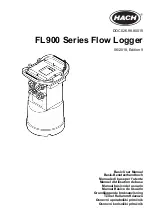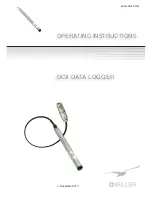
Chapter 5 Functional principle
5.3 Automatic selection of the GSM network
The GSM network to which the device should register must be selected, as the myDatalogNANO is equipped
with a SIM chip that provides a mobile connection via a variety of international service providers (see
www.microtronics.com/footprint). This is completed automatically by the device. During this process it is
taken into consideration if a connection to a certain GSM network is possible although the use of this GSM
network repeatedly causes transmission errors. Such a GSM network is added to a ban list and is ignored
during the next login attempt.
The following conditions ensure that the myDatalogNANO logs itself into a GSM network:
l
PowerOn
l
Initiation of ALOHA transmission mode (see "ALOHA transmission mode" on page 32)
l
Expiry of the transmission cycle if the "Interval" connection type was selected (see "Basic setting" on
page 87)
l
Activation of the "Interval & wakeup" or "Online" connection type (see "Basic setting" on page 87)
1. The myDatalogNANO checks whether any errors occurred during the last login attempt.
No errors:
The myDatalogNANO logs into the same GSM network that was also used during the last attempt.
Error:
Continue with step 2
Note:
A transmission error is not the same as an error that occurs when logging into the GSM
network. It is possible for the login to the GSM network to work correctly but that a transmission
error still occurs.
The following steps are only completed if an error was detected during step 1:
2. The device searches for GSM networks within its receiving range and creates a list of available GSM
networks.
3. A search of the list of available GSM networks is completed and the strongest GSM network is selected
that is not on the "ban list" and is assigned to one of the service providers supported by the integrated
SIM chip (see www.microtronics.com/footprint).
Note:
An explanation detailing the conditions when a GSM network is added to the "ban list" is provided
5.3.1 Ban list
The ban list provides space for 5 entries and is not saved in a volatile memory. This means that it is also still
available following a PowerOn.
If there is a "BEARER GPRS FAILED" error (see "Modem error" on page 114), then an internal counter is
increased by 2 . If a transmission was completed without errors, i.e. all of the data was transferred, this
internal counter is reduced by 1 . The current GSM network is added to the ban list if the internal counter
reaches the value 6 . The ban list is deleted if no GSM network can be selected from the list of available GSM
networks in the receiving range taking the ban list into consideration. Another search for GSM networks in the
receiving range is completed once the ban list is deleted and the network selection is completed with the ban
list that is now empty (see step 3 in chapter"Automatic selection of the GSM network" on page 33).
Rev. 02
33
Summary of Contents for myDatalogNANO
Page 2: ......
Page 8: ......
Page 9: ...Chapter 2 Declaration of conformity Chapter 2 Declaration of conformity Rev 02 9 ...
Page 10: ......
Page 12: ......
Page 22: ......
Page 34: ......
Page 38: ......
Page 58: ......
Page 92: ......
Page 108: ......
Page 118: ......
Page 120: ......
Page 126: ......
Page 130: ......













































